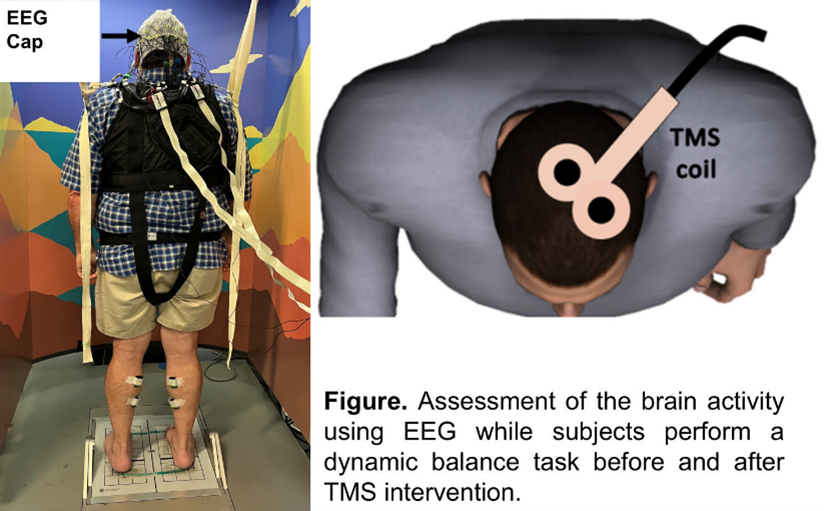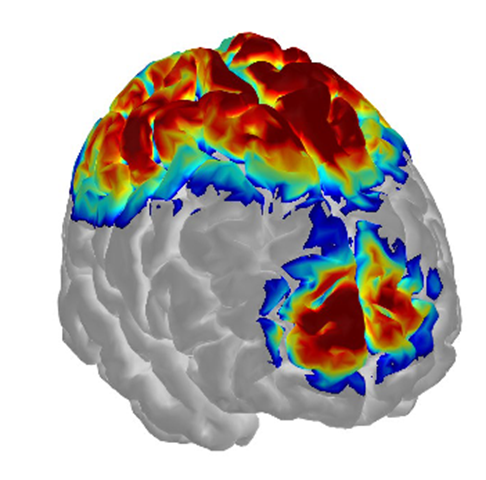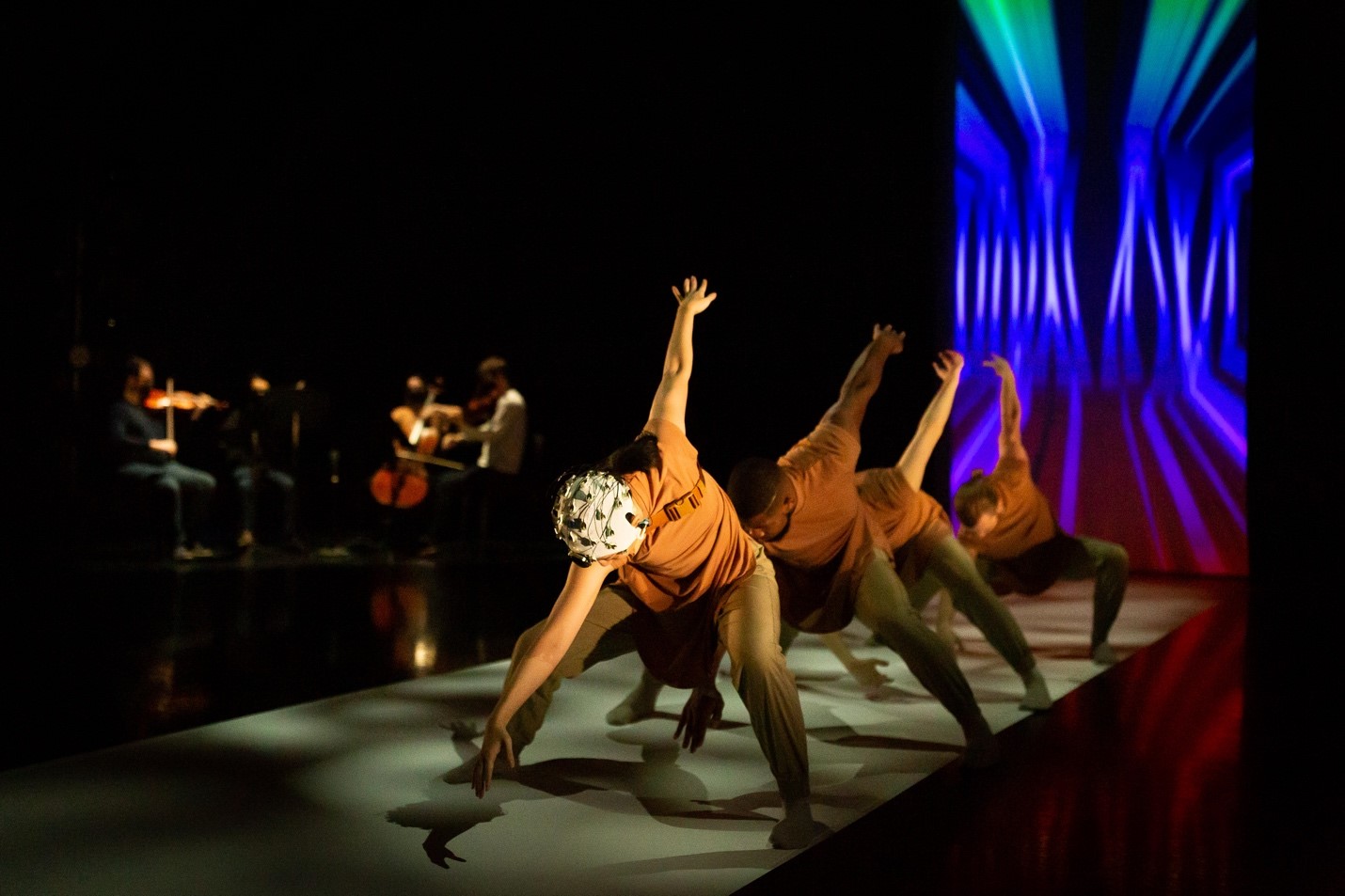Examples of NSAP project descriptions within the theme “Neuro Skill Advancement for Post-baccalaureate” are given below along with any specific project qualification necessary for success (e.g. specific courses or recommended background).
Project 1: Brain-Computer Interfaces to Help the Body Move Again (Contreras-Vidal, BMI Lab)

Figure 1. Pediatric exoskeleton.
Background: Devices that interface with the nervous system for diagnostic, therapeutic, or restorative purposes are a major locus of innovation in the US. Brain-Machine Interfaces (BMI), which translate brain activity into motor commands to external devices such as prosthetic limbs, are designed to help people with motor disabilities move again.14–19 Our Lab at the IUCRC BRAIN has pioneered EEG-based BMI systems for patients with limb amputation, stroke and spinal cord injury. However, these technologies are yet to be fully developed and validated for children or be fully integrated into clinical rehabilitation.
Research Plan: In our proposed project, we will embed NSAP trainees with a team of graduate student mentors, engineers and clinical collaborators in ongoing EEG-based BMIs to exoskeletons for children (Fig. 1) or adults with gait disabilities. NSAP trainees will be involved in all aspects of the research, including informed consent, data collection, neural decoding, and preparation of technical reports.
Prerequisites: An introductory course in signals and systems and knowledge of Matlab are desirable.
Project 2: Effects of Transcranial Magnetic Stimulation on the Brain and Balance in the Elderly (Parikh Lab, CNBR Lab)

Background: Falls and fall-related injuries are a growing public health concern in the elderly. When older adults are affected by neurological conditions, the risk of falling increases substantially. Falls and the resulting fear of falls can mark the beginning of a decline in function, participation in social activities, and independence, thus negatively affecting the quality of life. Loss of balance is one of the common precipitants of falls. Older adults often have alterations in the brain balance circuit that cause ineffective responses to prevent a fall when the balance is challenged. In this project, we will examine the effects of an MRI-guided repetitive transcranial magnetic stimulation (TMS) protocol on the brain balance circuit assessed using electroencephalography and balance behavior in elderly individuals.
Research Plan: We will pair NSAP trainees with graduate student mentors to investigate how the magnetic stimulation of the brain influences the network for balance control within affected and non-affected hemispheres in stroke patients. NSAP trainees will be involved in all aspects of the research including informed consent, data collection & analysis, and dissemination of research findings.
Prerequisites: An introductory programming course, preferably using C/C++ and/or Python is desirable.
Project 3: Effects of Aging on Bottom-Up and Top-Down Influences During Sentence Comprehension: Evidence From Event-Related Potentials (Dial)

Background: Both younger and older adults use semantic prediction during auditory comprehension. However, age-related declines in hearing and cognitive control make older adults a) more reliant on semantic prediction and b) less able to inhibit predictions when faced with conflicting information. One method used to study this is the false hearing paradigm, in which participants listen to sentences biased toward one word of a phonologically similar word pair (e.g., BEACH/PEACH) and report what they heard. For example, when hearing “The man ate a ripe BEACH,” older adults are more likely to report hearing “The man ate a ripe PEACH,” the word that semantically fits the sentence. The proposed study aims to uncover the neural mechanisms behind this effect using event-related potentials (ERPs). Specifically, we will examine the N400 component across three conditions: (1) congruent sentences, (2) incongruent sentences correctly identified as nonsensical (accurate perception), and (3) incongruent sentences mistakenly judged as meaningful (false hearing). Understanding the factors that influence auditory comprehension in aging can inform strategies to support comprehension, particularly in the context of hearing loss and impaired language processing.
Research Plan: An NSAP trainee will work with the PI and a graduate student mentor to investigate the mechanisms underlying false hearing. The NSAP trainee will be involved in informed consent, data collection & analysis, and dissemination of research findings.
Prerequisites: Some experience with EEG data collection or analysis is desirable but not required.
Project 4: Neuromuscular Pain Manifestation In Women (Gorniak)

Background: The goal of the proposed project is to identify the origins of neuromuscular arm, shoulder, and back pain in women. While multiple mechanistic pathways likely contribute to the manifestation of pain, we have limited insight into the interaction of these complex causes, particularly in women. In this project, complementary data from a variety of sources are collected to improve understanding in how neuromuscular pain develops and manifests across the lifespan in women.
Research Plan: We will pair NSAP trainees with graduate student mentors to investigate the multifactorial roots of neuromuscular pain manifestation in women. Data collection types will include behavioral assessment, neuromuscular stimulation, biomechanical assessment, and functional neuroimaging. NSAP trainees will be involved in all aspects of the research including data collection, data analysis, and dissemination of research findings.
Prerequisites: Introductory course work in: Anatomy & Physiology and Computer Programming. Coursework in foundations of functional neuroimaging, biomechanics, and proficiency in signal processing would be ideal, but not required.
Project 5: Development of the Syntec System for Rapid Traumatic Brain Injury (TBI) Assessment (Feng)

The prototype was tested with human subjects, and the data were processed using MATLAB.
Background: Traumatic brain injury (TBI) refers to a disruption of normal brain function caused by a bump, blow, jolt, or penetrating head injury. Military service members (SMs) face elevated risks of TBI from falls, car accidents, strikes, and even blast exposures in combat or training settings. While there are some established methods for TBI diagnosis, there is an acute need for an accessible personal device for on-site, timely assessment and diagnosis. Syntec project explores a novel method to assess brain health through a wearable device with a new brain-computer interface.
Research Plan: In Syntec project, we will embed an NSAP trainee with a graduate research mentor and clinical collaborators in ongoing human subject testing, data collection, and data analysis. NSAP trainees will be involved in all aspects of the research, including informed consent, data collection, neural processing and decoding, and preparation of technical reports.
Prerequisites: An introductory course in signals and systems and knowledge of MATLAB are desirable.
Project 6: Neuromusclar Coordination-guided Rehabilitation after Neurological Disorders (Roh at University of Houston)

KAIST Upper Limb Synergy Identification System.
Background: Stroke induces alterations in neuromuscular coordination. As the level of motor impairment increases, the prevalence of abnormal motor coordination increases. Is there any way to improve impaired motor coordination through human-robot interaction? If so, how? Students will be involved in scientific investigation and engineering application development in relation to the topic.
Research Plan: We will pair NSAP trainees with graduate student mentors to investigate whether a novel rehabilitation exercise by using human-machine interface induces newly emerging intermuscular coordination patterns in the upper extremity of stroke survivors with severe impairment. NSAP trainees will be involved in all aspects of the research including informed consent, supporting research participants’ training, data collection & analysis, and dissemination of research findings.
Prerequisites: An introductory programming course, preferably using MATLAB is desirable.
Project 7: Gait Retraining to Improve Mobility in Cerebral Disorders (Shourijeh and Francisco at University of Texas Health Science Center at Houston and Neurorecovery Research Center at TIRR Memorial Hermann)

Physics-informed data-driven approach for lower-limb gait retraining.
Background: The ability to regain walking remains one of the most important predictors of long-term quality of life for individuals with cerebral neurological conditions such as stroke, brain injury, and cerebral palsy. Walking is essential not only for independent function but also for preventing secondary complications that commonly arise after neurological injury, including cardiovascular deconditioning, muscle atrophy, and bone density loss.
Recent advances in neurorehabilitation have expanded the use of gait-retraining strategies, including task-specific overground gait practice, treadmill-based training, sensory cueing, and real-time biofeedback. These approaches facilitate high-repetition, task-specific practice that can drive neuroplasticity by modulating neuronal excitability and reorganizing motor pathways at both cortical and subcortical levels. When combined with modern computational tools, such as physics-based neuromusculoskeletal models and data-driven analytical methods, gait retraining can be better tailored to individual motor deficits. Together, these approaches support improved motor control, more efficient gait patterns, and enhanced overall mobility for people with cerebral motor impairments.
Research Plan: We will pair NSAP trainees with graduate student mentors to investigate how gait-retraining interventions influence locomotor function in individuals with cerebral neurological disorders. Trainees will employ both physics-based neuromusculoskeletal modeling (e.g., muscle-driven simulations, inverse dynamics, and motor control estimation) and data-driven approaches (e.g., machine learning, pattern recognition, and statistical modeling) to characterize gait mechanics and training responses. NSAP trainees will participate in data collection, signal processing, biomechanical analysis, interpretation of training outcomes, and dissemination of research findings.
Prerequisites: An intermediate-level programming course, preferably using MATLAB, is required.
Project 8: Communication Recovery After Stroke: Examining Apragmatism (Blake)

Background: Pragmatics is a component of language that involves the use of linguistic (word choice, sentence structure, organization of sentences & ideas), paralinguistic (tone of voice), and extralinguistic (non-verbal cues such as body language, facial expressions & gestures) cues to convey meaning within a communicative context. These are commonly used to emphasize a point, to avoid ambiguity, or when the literal meaning of what you say is not your intended meaning, such as when telling a joke, being sarcastic, or using idioms or metaphors. Strokes affecting the right side of the brain can result in a communication deficit called apragmatism that disrupts the pragmatic component of language. Apragmatism can affect social interactions, relationships, and the ability to keep or return to a job.
Research Plan: We will pair NSAP trainees with mentors to study pre- and post-stroke samples of communication to identify production of linguistic, paralinguistic, and/or extralinguistic aspects of pragmatics and how those change over time with recovery from stroke. NSAP trainees will be involved in data collection & analysis, and dissemination of research findings.
Prerequisites: An interest in language and communication.
Project 9: The Neural Basis of the Creative Process in Dance and Music (Contreras-Vidal)

Background: Music and dance are powerful neuromodulators that affect multiple brain systems, and thereby our mood, movement, creativity, emotions, social interaction health and wellbeing. However, most studies investigating the neural basis of music and dance have been constrained to lab settings and methodologies that prevent the study of the brain “in action and in context” in ecological settings.
Research Plan: In this project, we will embed NSAP trainees with a team of neuroscientists, engineers, musicians, dancers, choreographers, graduate and undergraduate researchers, and clinical collaborators. NSAP trainees will work closely with Dr. Contreras-Vidal and his team to examine how the brain of dancers and/or musicians are engaged and communicate with each other during performance. NSAP trainees will have opportunities to be involved in designing brain-computer interfaces based on inter-brain synchrony measurements, functional mapping and other neuroscience and neuroengineering tools. NSAP trainees will be involved in all aspects of the research informed consent, data collection and analysis, and dissemination of research findings.
Prerequisites: Knowledge of MATLAB programming, signal processing, biomechanics, music, dance or art therapy is desirable.
Project 10: Quantifying Motor Function in Children with Cerebral Palsy (Parikh, CNBR Lab)

Background: In the United States, cerebral palsy (CP) affects 3-4 per 1000 live births (CDC) with hemiplegic cerebral palsy comprising 30% of cases. CP impairs the spontaneous use of the hand for daily manual activities, thus affecting functional independence and diminishing their quality of life. Current clinical tests only provide a qualitative assessment of performance via observation (i.e., a rating scale) or through perceptual judgment and/or they focus on the speed/time to complete the task. We have developed an objective activity-based measure of hand function in children, the Bead Maze hand function (BMHF) test (see the figure). The test has been implemented in typically developing children (Rose et al, 2024; American Journal of Occupational Therapy). Here, children are required to perform a multi-joint movement to complete an unimanual functional task of positioning and/or orienting the bead in relation to the wire. The forces imparted on the wire while maneuvering the bead and the test completion time are quantified. The test is designed to capture sensorimotor behavior for manual activities.
Research Plan: We will pair NSAP trainees with graduate student mentors to study whether the BMHF test can be used to capture hand function in children with CP. Another aspect of the project will focus on identifying suitable biomarkers or predictors of impairment using advanced statistical methods. NSAP trainees will be involved in all aspects of the research including informed consent, data collection & analysis, and dissemination of research findings.
Prerequisites: An introductory programming course, preferably using MATLAB.